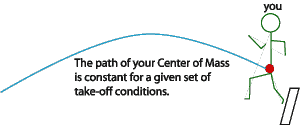
Long Jump
Tracey Kobayashi
50 Phelan Ave, NGYM
San Francisco, CA 94112
(415)452-7311
tkobayas@ccsf.edu
PE 9A: Fit or Fat
College & Career Ed
PE 50: Fitness Center

IM Me!
AIM - TKatCCSF
Yahoo - tkobico
ICQ - 155909399
Updated by Tracey 9 September 2001
Track & Field page |
Intro
Sprinting |
Long Jump |
High Jump
Javelin
As we move on to the Long Jump, I would like to begin as I always do by boring you with Fizz - Iks. This time, I'd like to discuss projectiles. When most of you think of projectiles, you probably envision things like baseballs hit by Barry Bonds, or the poor sucker at the party who tied one too many on. However, when you launch your body off the ground, you too become a projectile, not unlike the nutcase who shoots himself out of the cannon. As such, you're subject to many of the same physical laws. For example, once you're off the ground, your horizontal velocity (give or take some air resistance), is pretty much set, you move toward the earth at a rate of 9.8 m/s², and your body rotates around its center of mass. This is true of any projectile, whether it be a javelin, shot, discus, or yes, even a human. For the most part, once you're off the ground, there's nothing you can do to change the path of your center of mass, so a jumper wants to fine-tune the approach in order to optimize take-off velocity. The motions the jumper makes in the air control rotation around the center of mass to optimize landing position.

For a description of fundamental long jump mechanics, see the description by Coach Ernie Gregoire of Mt San Antonio College. If you can get past the fact that his command of the English language is a bit less than exemplary, Ragnar Lundqvist also has a good description of basic mechanics and diagrams that illustrate his points, as well as age-based training progressions. Eteams has drills and descriptions of different long jump techniques, although I have to say I'm disappointed in their lack of photos or graphics which would have helped readers visualize their descriptions.
Track & Field page |
Intro
Sprinting |
Long Jump |
High Jump
Javelin